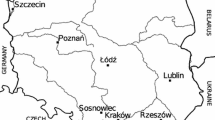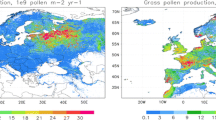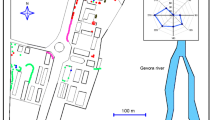Abstract
Aerobiological studies mostly apply linear models when analysing long-term changes in pollen concentrations. There is some evidence that linear models are not fully suitable for describing these changes in recent decades since pollen concentrations of some species have increased until 1990 and decreased subsequently. In order to describe the behaviour of annual pollen concentrations (a factor contributing to the incidence of allergies) in a more flexible way, we made use of Bayesian statistics that describe discontinuities (i.e. change points) and quantify the direction and speed of changes. We examined long-term aerobiological pollen data of Betula spp. (birch), Corylus spp. (hazel) and Poaceae (grasses) from six stations in Switzerland (Basel, Buchs, Davos, Münsterlingen, Neuchâtel and Zurich) for the period 1985–2014. For most of the analysed stations and species, the one change point model was considered as the best model. The only exceptions were Corylus pollen time series recorded at Neuchâtel and Zurich that could be better described with the linear model. The results indicated that all pollen records of Corylus were characterized by increased pollen concentrations in recent years. For Betula pollen concentrations, four sites were associated with recent decreases; increases were only found for Buchs and Münsterlingen. Regarding Poaceae pollen, half of the stations (N = 3) were linked to decreases. Trends of linear regressions differed considerably in magnitude or even differed in sign compared to the Bayesian results. Our results indicate that the choice of the statistical method is of major importance when interpreting aerobiological data. Further studies should focus on the reasons (climate, land use changes, etc.) responsible for changes in atmospheric pollen loads in detail.





Similar content being viewed by others
References
Albertine, J. M., Manning, W. J., DaCosta, M., Stinson, K. A., Muilenberg, M. L., & Rogers, C. A. (2014). Projected carbon dioxide to increase grass pollen an allergen exposure despite higher ozone levels. PLoS ONE, 9(11), e111712. https://doi.org/10.1371/journal.pone.0111712.
Beggs, P. J. (2004). Impacts of climate change on aeroallergens: Past and future. Clinical and Experimental Allergy, 34, 1507–1513.
Bonini, M., Šikoparija, B., Prentović, M., Cislaghi, G., Colombo, P., Testoni, C., et al. (2016). A follow-up study examining airborne Ambrosia pollen in the Milan area in 2014 in relation to the accidental introduction of the ragweed leaf beetle Ophraella communa. Aerobiologia, 32, 371–374. https://doi.org/10.1007/s10453-015-9406-2.
Bossuyt, N., Wirthner, J., Dussoulier, C., Frund, D., Meisser, M., Ampuero Kragten, S., et al. (2018). Wann sollten intensiv genutzte Wiesen gemäht werden? Agrarforschung Schweiz, 9, 12–19.
Braun-Fahrländer, C., Gassner, M., Grize, L., Takken-Sahli, K., Neu, U., Stricker, T., et al. (2004). No further increase in asthma, hay fever and atopic sensitisation in adolescents living in Switzerland. European Respiratory Journal, 23(3), 407–413.
Burr, M. L., Emberlin, J. C., Treu, R., Cheng, S., Pearce, N. E., & The ISAAC Phase One Study Group. (2003). Pollen counts in relation to the prevalence of allergic rhinoconjunctivitis, asthma and atopic eczema in the International Study of Asthma and Allergies in Childhood (ISAAC). Clinical and Experimental Allergy, 33, 1675–1680.
Buters, J., Thibaudon, M., Smith, M., Kennedy, R., Rantio-Lehtimäki, A., Albertini, R., et al. (2012). Release of Bet v 1 from birch pollen from 5 European countries. Results from the HIALINE study. Atmospheric Environment, 55, 496–505.
Clot, B. (2003). Trends in airborne pollen: An overview of 21 year of data in Neuchâtel (Switzerland). Aerobiologia, 19, 227–234.
D’Amato, G., Spieksma, F. T. M., & Bonini, S. (Eds.). (1991). Allergenic pollen and pollinosis in Europe (pp. 109–112). Oxford: Blackwell Science.
de Weger, L. A., Bergmann, K. C., Rantio-Lehtimäki, A., Dahl, A., Buters, J., Déchamp, C., et al. (2013). Impact of pollen. In M. Sofiev & K.-C. Bergmann (Eds.), Allergenic Pollen: A review of the production, release, distribution and health impacts (pp. 161–215). New York: Springer.
Dose, V., & Menzel, A. (2004). Bayesian analysis of climate change impacts in phenology. Global Change Biology, 10, 259–272.
Dose, V., & Menzel, A. (2006). Bayesian correlation between temperature and blossom onset data. Global Change Biology, 12, 1451–1459.
Emberlin, J. (1994). The effects of patterns in climate and pollen abundance on allergy. Allergy, 49, 15–20.
Emberlin, J., Mullins, J., Coren, J., Jones, S., Millinton, W., Brooke, M., et al. (1999). Regional variations in grass pollen seasons in the UK, long-term trends and forecast models. Clinical and Experimental Allergy, 29, 347–356.
Federal Statistical Office. (2015). Swiss Agriculture. Pocket Statistics 2015. https://www.bfs.admin.ch/bfs/en/home/news/whats-new.assetdetail.349914.html. Accessed 1 Aug 2018.
Frei, T. (1997). Pollen distribution at high elevation in Switzerland: Evidence for medium range transport. Grana, 36, 34–38.
Frei, T. (1998). The effects of climate change in Switzerland 1969–1996 on airborne pollen quantities from hazel, birch and grass. Grana, 37, 172–179.
Frei, T., & Gassner, E. (2008a). Climate change and its impacts on birch pollen quantities and the start of the pollen season an example from Switzerland for the period 1969–2006. International Journal of Biometeorology, 52, 667–674.
Frei, T., & Gassner, E. (2008b). Trends in prevalence of allergic rhinitis and correlation with pollen counts in Switzerland. International Journal of Biometeorology, 52, 841–847.
Frenguelli, G., Passalacqua, G., Bonini, S., Fiocchi, A., Incorvaia, C., Marcucci, F., et al. (2010). Bridging allergologic and botanical knowledge in seasonal allergy: A role for phenology. Annals of Allergy, Asthma & Immunology, 105, 223–227.
Fuhrmann, C. M., Sugg, M. M., & Konrad, C. E., II. (2016). Airborne pollen characteristics and the influence of temperature and precipitation in Raleigh, North Carolina, USA (1999–2012). Aerobiologia. https://doi.org/10.1007/s10453-016-9442-6.
Galán, C., Ariatti, A., Bonini, M., Clot, B., Crouzy, B., Dahl, A., et al. (2017). Recommended terminology for aerobiological studies. Aerobiologia, 33, 293–295.
Galán, C., Smith, M., Thibaudon, M., Frenguelli, G., Oteros, J., Gehrig, R., et al. (2014). Pollen monitoring: minimum requirements and reproducibility of analysis. Aerobiologia, 16, 339–346.
Garrett, A. J. M. (1991). Ockham’s razor. In: W. T. Grandy, L. H. Schick (Eds.), Maximum entropy and bayesian methods. Fundamental theories of physics (An International Book Series on the Fundamental Theories of Physics: Their Clarification, Development and Application), (vol 43, pp. 357–364). Dordrecht: Springer.
Gehrig, R., Gassner, M., & Schmid-Grendelmeier, P. (2015). Alnus × spaethii pollen can cause allergies already at Christmas. Aerobiologia, 31, 239–247.
Gehrig, R., & Peeters, A. G. (2000). Pollen distribution at elevations above 1000 m in Switzerland. Aerobiologia, 16(1), 69–74.
Ghitarrini, S., Tedeschini, E., Timorato, V., & Frenguelli, G. (2016). Climate change: consequences on the pollination of grasses in Perugia (Central Italy). A 33-year-long study. International Journal of Biometeorology. https://doi.org/10.1007/s00484-016-1198-8.
Grize, L., Gassner, M., Wüthrich, B., Bringolf-Isler, B., Takken-Sahli, K., Sennhauser, F. H., et al. (2006). Trends in prevalence of asthma, allergic rhinitis and atopic dermatitis in 5–7-year old Swiss children from 1992 to 2001. Allergy, 61, 556–562.
Guedes, A., Ribeiro, N., Ribeiro, H., Oliveira, M., Noronha, F., & Abreu, I. (2009). Comparison between urban and rural pollen of Chenopodium alba and characterization of adhered pollutant aerosol particles. Aerosol Science, 40, 81–86.
Henneken, R., Dose, V., Schleip, C., & Menzel, A. (2013). Detecting plant seasonality from webcams using Bayesian multiple change point analysis. Agricultural and Forest Meteorology, 168, 177–185.
Jochner, S., Höfler, J., Beck, I., Göttlein, A., Ankerst, D. P., Traidl-Hoffmann, C., et al. (2013). Nutrient status: A missing factor in phenological and pollen research? Journal of Experimental Botany, 64(7), 2081–2092.
Jochner, S., Lüpke, M., Weichenmeier, I., Pusch, G., Traidl-Hoffmann, C., Schmidt-Weber, C., et al. (2015). Seasonal variation of birch and grass pollen loads and allergen release at two sites in the German Alps. Atmospheric Environment, 122, 83–93.
Jochner, S., Ziello, C., Böck, A., Estrella, N., Buters, J., Weichenmeier, I., et al. (2012). Spatio-temporal investigation of flowering dates and pollen counts in the topographically complex Zugspitze area on the German-Austrian border. Aerobiologia, 28, 541–556.
Langen, U., Schmitz, R., & Steppuhn, H. (2013). Häufigkeit allergischer Erkrankungen in Deutschland. Ergebnisse der Studie zur Gesundheit Erwachsener in Deutschland (DEGS1). Bundesgesundheitsblatt, 56, 698–706.
Leuschner, R. M., Christen, H., Jordan, P., & Vonthein, R. (2000). 30 years of studies of grass pollen in Basel (Switzerland). Aerobiologia, 16, 381–391.
Matricardi, P. M. (2001). Prevalence of atopy and asthma in eastern versus western Europe: Why the difference. Annals of Allergy, Asthma & Immunology, 87(6 Suppl 3), 24–27.
MeteoSwiss. (2018). Temperature and precipitation trends. https://www.meteoswiss.admin.ch/home/climate/climate-change-in-switzerland/temperature-and-precipitation-trends.html. Accessed 15 Aug 2018.
Newnham, R. M., Sparks, T. H., Skjøth, C. A., Head, K., Adams-Groom, B., & Smith, M. (2013). Pollen season and climate: Is the timing of birch pollen release in the UK approaching its limit? International Journal of Biometeorology, 57, 391–400.
Nowak, D., Wichmann, H. E., & Magnussen, H. (1998). Asthma and atopy in Western and Eastern communities—Current status and open questions. Clinical and Experimental Allergy, 28, 1043–1046.
Pawankar, R., Canonica, G. W., Holgate, S. T., & Lockey, R. F. (Eds.) (2011). WAO White Book on Allergy 2011–2012: Executive summary. Milwaukee: World Allergy Organization. www.worldallergy.org/publications/wao_white_book.pdf. Accessed 7 Oct 2017.
Pope, K. S., Dose, V., Da Silva, D., Brown, P. H., Leslie, C. A., & DeJong, T. M. (2013). Detecting nonlinear response of spring phenology to climate change by Bayesian analysis. Global Change Biology, 19(5), 1518–1525.
Rasmussen, A. (2002). The effects of climate change on the birch pollen season in Denmark. Aerobiologia, 18, 253–265.
Rehsteiner, R. (1926). Beiträge zur Kenntnis der Verbreitung des Heufiebers. Schweiz Zeitschrift für Gesundheitspflege, 1, 1–33.
Ring, J., Krämer, U., Schäfer, T., & Behrendt, H. (2001). Why are allergies increasing? Current Opinion in Immunology, 13, 701–708.
Sikoparija, B., Skjøth, C. A., Celenk, S., Testoni, C., Abramidze, T., Alm Kübler, K., et al. (2017). Distribution and trends in airborne Ambrosia pollen across Europe. Aerobiologia, 33, 181–189.
Simoleit, A., Wachter, R., Gauger, U., Werchan, M., Werchan, B., Zuberbier, T., et al. (2016). Pollen season of European beech (Fagus sylvatica. L) and temperature trends at two German monitoring sites over a more than 30-year period. Aerobiologia. https://doi.org/10.1007/s10453-016-9421-y.
Skjøth, C., Ørby, P. V., Becker, T., Geels, C., Schlünssen, V., Sigsgaard, T., et al. (2013). Identifying urban sources as cause of elevated grass pollen concentrations using GIS and remote sensing. Biogeosciences, 10, 541–554.
Smith, M., Jäger, S., Berger, U., Sikoparija, B., Hallsdottir, M., Sauliene, I., et al. (2014). Geographic and temporal variations in pollen exposure across Europe. Allergy, 69, 913–923.
Spieksma, F. T. M., Corden, J., Detandt, M., Millington, W., Nikkels, H., Nolard, N., et al. (2003). Quantitative trends in annual totals of five common airborne pollen types (Betula, Quercus, Poaceae, Urtica, and Artemisia), at five pollen-monitoring stations in western Europe. Aerobiologia, 19, 171–184.
Swiss Federal Statistical Office (SFSO) & Federal Office for the Environment (FOEN). (1998). CORINE Land Cover (CLC) 1990. https://www.wsl.ch/de/projekte/corine-schweiz.html. Accessed 1 Aug 2018.
The European Environment Agency. (2016a). CORINE Land Cover (CLC) 1990 (version 18.5). https://land.copernicus.eu/pan-european/corine-land-cover. Accessed 1 Aug 2018.
The European Environment Agency (2016b). CORINE Land Cover (CLC) 2012 (version 18.5). https://land.copernicus.eu/pan-european/corine-land-cover. Accessed 1 Aug 2018.
Ugolotti, M., Pasquarella, C., Vitali, P., Smith, M., & Albertini, R. (2015). Characteristics and trends of selected pollen seasons recorded in Parma (Northern Italy) from 1994 to 2011. Aerobiologia, 31, 341–352.
Voltolini, S., Minale, P., Troise, C., Bignardi, D., Modena, P., Arobba, D., et al. (2000). Trend of herbaceous pollen diffusion and allergic sensitisation in Genoa, Italy. Aerobiologia, 16, 245–249.
Wüthrich, B. (1989). Epidemiology of allergic diseases: Are they really in the increase? International Archives of Allergy and Applied Immunology, 90, 3–10.
Wüthrich, B., Schindler, C., Leuenberger, P., & Ackermann-Liebrich, U. (1995). Prevalence of atopy and pollinosis in the adult population of Switzerland (SAPALDIA Study. International Archives of Allergy and Immunology, 106(2), 149–156.
Ziello, C., Sparks, T. H., Estrella, N., Belmonte, J., Bergmann, K. C., Bucher, E., et al. (2012). Changes to airborne pollen counts across Europe. PLoS ONE. https://doi.org/10.1371/journal.pone.0034076.
Ziska, L. H., Gebhard, D. E., Frenz, D. A., Faulkner, S., Singer, B. D., & Straka, J. G. (2003). Cities as harbingers of climate change: Common ragweed, urbanization, and public health. Journal of Allergy and Clinical Immunology, 111, 290–295.
Acknowledgements
We thank the Working group of Aerobiology, R.M. Leuschner and A.G. Peeters, for providing the pollen data of Switzerland before 1993. We also acknowledge Johanna Jetschni’s GIS support.
Author information
Authors and Affiliations
Corresponding author
Rights and permissions
About this article
Cite this article
Jochner-Oette, S., Menzel, A., Gehrig, R. et al. Decrease or increase? Temporal changes in pollen concentrations assessed by Bayesian statistics. Aerobiologia 35, 153–163 (2019). https://doi.org/10.1007/s10453-018-9547-1
Received:
Accepted:
Published:
Issue Date:
DOI: https://doi.org/10.1007/s10453-018-9547-1




